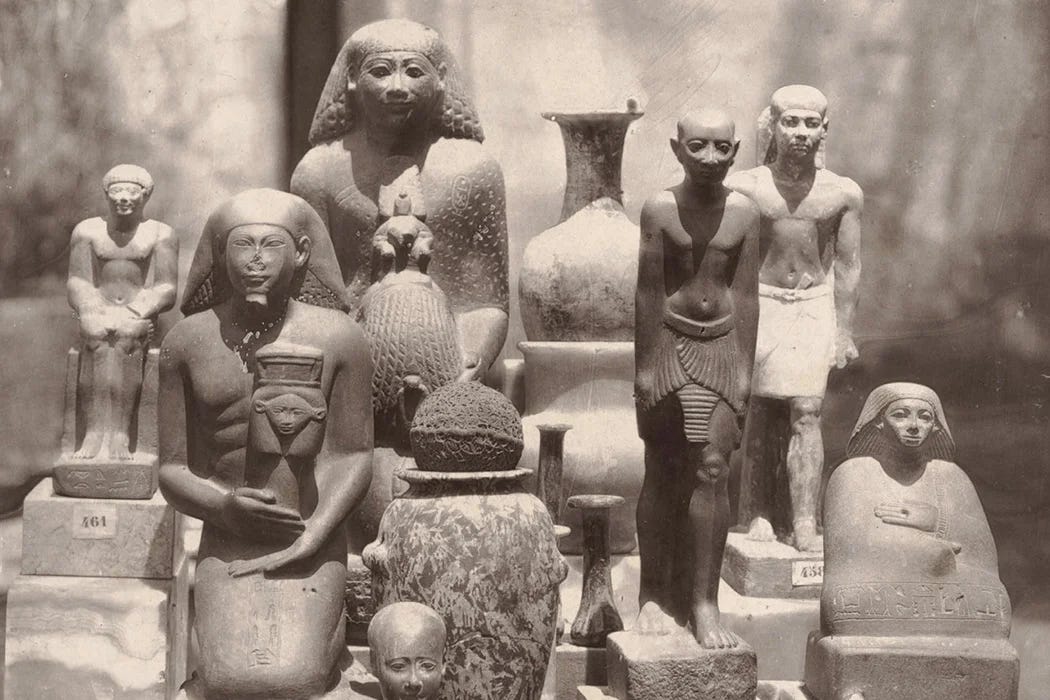Unruly History in the News #34
Facial reconstructions, secrets hidden in Anne Boleyn's book of hours,
Hey everyone,
I’m going the next two weeks, August 27th & September 3rd, off of these round-ups because I’ll be visiting family and won’t be checking the news as much. So I made today’s extra long to make up for it! I’ve got some other posts already scheduled out between now and then, but if you’re sending me emails or leaving comments, I won’t be responding as quickly as I usually do.
If you’re in the US, have a lovely Labor Day weekend, and if you’re elsewhere, well, have a great couple of weeks!
This week, in history acting unruly….
Remember Henrietta Lacks, the woman whose cells were taken without her consent and formed the basis of a lot of our modern medical science? Her family has settled a lawsuit with the biotech company that stole her cells.
When Anne Boleyn was executed in 1536, her Book of Hours went missing. It’s been found, and it’s revealing all kinds of secrets.

Safeguarding Anne Boleyn’s Book of Hours for centuries was the communal work of aunts and nieces, daughters and mothers. Their names are preserved in the book’s margins. Image source: Hever Castle & Gardens. In facial reconstructions:
700 years ago, the Bocksten man was murdered, his body stored at the bottom of a bog with a stake through the chest. The murderer probably thought the body would decompose, but “The watery environment protected not only Bocksten Man's shock of curly hair but also his wardrobe, among some of the best examples of medieval European clothing. He wore a hood, heavy cloak, woven tunic, woolen hose, and leather shoes. Analysis of his garments and his body revealed that he was a person of some stature and wealth.” No word yet on who the murderer was, but a facial reconstruction has been completed.
Speaking of bogs—this accidental mummification happens more than you’d think! Here are a few ways human remains have accidentally been preserved over the years.
In a cave in Gibraltar in 1996, a skull was found. In 2019, it was confirmed to be the skull of a woman who lived 7,500 years ago, making her the earliest human remains found on the island. Now named Calpeia, a facial reconstruction has been recently finished, showing us what she looked like.

Facial reconstruction of Calpeia, who lived 7,500 years ago. Image from Gibraltar National Museum And in the facial reconstructions that can’t happen yet: 5 dozen Icelandic “crania” are sitting in a basement at Harvard’s Peabody Museum. Just the skulls; the rest of the skeletons remain in Iceland. Why? Well because they were part of a eugenics campaign (supported by Harvard) that sought to position the Nordic/Icelandic peoples as “pure.” Iceland would like these Medieval skulls back, please and thank you.
Here, take an unprecedented look inside Jerusalem’s Dome of the Rock, the religious site at the center of a geopolitical nightmare.
Using laser scans, archaeologists at the University of Exeter have discovered that a small town in Devon was once a strategically important location to ancient Romans who lived in what is now the UK.
In what reads as spoilers of the less-murdery part of The Cloisters come to life, 30-year veteran curator Peter Higgs was apparently stealing from his job—the British Museum. He allegedly took uncategorized items worth hundreds of millions of British pounds and sold them on eBay.
Despite her majesty—and size—who actually built the Sphinx is still debated. Also? We’re not really sure what happened to her nose. It definitely wasn’t Napoleon, as travel journals that pre-date Napoleon show a noseless creature. Apparently, she still contains mysteries.
Making Egypt’s museums: It took 20 years, but the Grand Egyptian Museum, the largest archaeological museum in the world, is finally slated to open at the end of 2023. This is a lovely, long history of the practice of exhibiting sarcophagi and other Egyptian artifacts.

Several statues from different periods of Egyptian history, Boulaq Museum, 1872. Photo from JSTOR. Archaeologists are deeply concerned about displaying a 3rd-century floor mosaic that depicts Jesus at the Museum of the Bible in Washington, D.C. The museum was founded by right-wing Evangelical Christian Steve Green, president of Hobby Lobby. The museum has faced criticism over collection practices (and has had to repatriate several objects), and Green has personally had countless looted arguments seized from his personal collections. Moreover, the mosaic has not been adequately studied and people are concerned about whether it will survive being moved.
And speaking of the Bible, these 12 men are household names for many—but did the Apostles really exist? Historical evidence (and lack thereof) contradicts a lot of Christian beliefs about Jesus’s inner circle.
According to the Indian government, 31 antiquities have been stolen from various protected monuments and sites around India over the last ten years. Only 4 have been recovered so far.
I feel like we really get archaeological news out of Canada, so this is really exciting: A First Nations village—including a 1,000-year-old fish trap—has been discovered in Victoria, British Columbia. Due to the rapid urbanization of British Columbia, it is rare to find any ancient evidence in the area.
In Russia news:
Ukraine has launched an interesting attack in its ongoing war against Russia: A public, searchable database of art owned by sanctioned Russian oligarchs. The goal of the database is to make it hard for oligarchs to sell their art if they’re feeling an economic pinch due to sanctions. Additionally, it could make it harder for them to launder money through art purchases—money that often goes to support the invasion of Ukraine.
And speaking of Russia, did you know that about 5,000 American soldiers were embroiled in the 1917 Russian Revolution? These “polar bear” soldiers were sent into Russia to try to draw the country back into WWI; without the Eastern Front of the war, the Axis powers were free to focus all their military might on the Western Front, and the Allies were not excited about that prospect.
Finally, are there (secret) dead Russian cosmonauts orbiting the Earth?
covered the harrowing conspiracy theory on .
The bones of this 37-million-year-old whale are so large that archaeologists initially thought they were boulders, not a skeleton.
You’d think we know everything about the Battle of Bulge since it only happened 80 years ago and we have plenty of historical documentation of it, including testimony from the people that survived it. But recent drone scans of the densely forested area have revealed all sorts of things we weren’t aware of.
Arthur, the ultimate founding myth of the UK (despite the fact that, if he was even real, he might have been from France). This article asks, how does Arthur, the ultimate Good Guy, influence British thought today?
Is there an Indigenous metropolis hidden under a lake in Wisconsin? The story of US westward expansion necessarily destroyed a lot of the evidence of Indigenous people, but evidence of ancient groups is turning up more and more in our lakes.





It's interesting to discover conspiracies and their concomitant fake news from centuries ago. Last year I reviewed an exhibition at the London Library called Breaking the News, which featured examples of old pamphlets with lurid (and ludicrous) headlines! (See https://schoolsweek.co.uk/review-breaking-the-news-at-the-british-library/ if you're interested.)
I always find it fascinating, and poignant, to see reconstructed faces of people who lived hundreds of years ago.